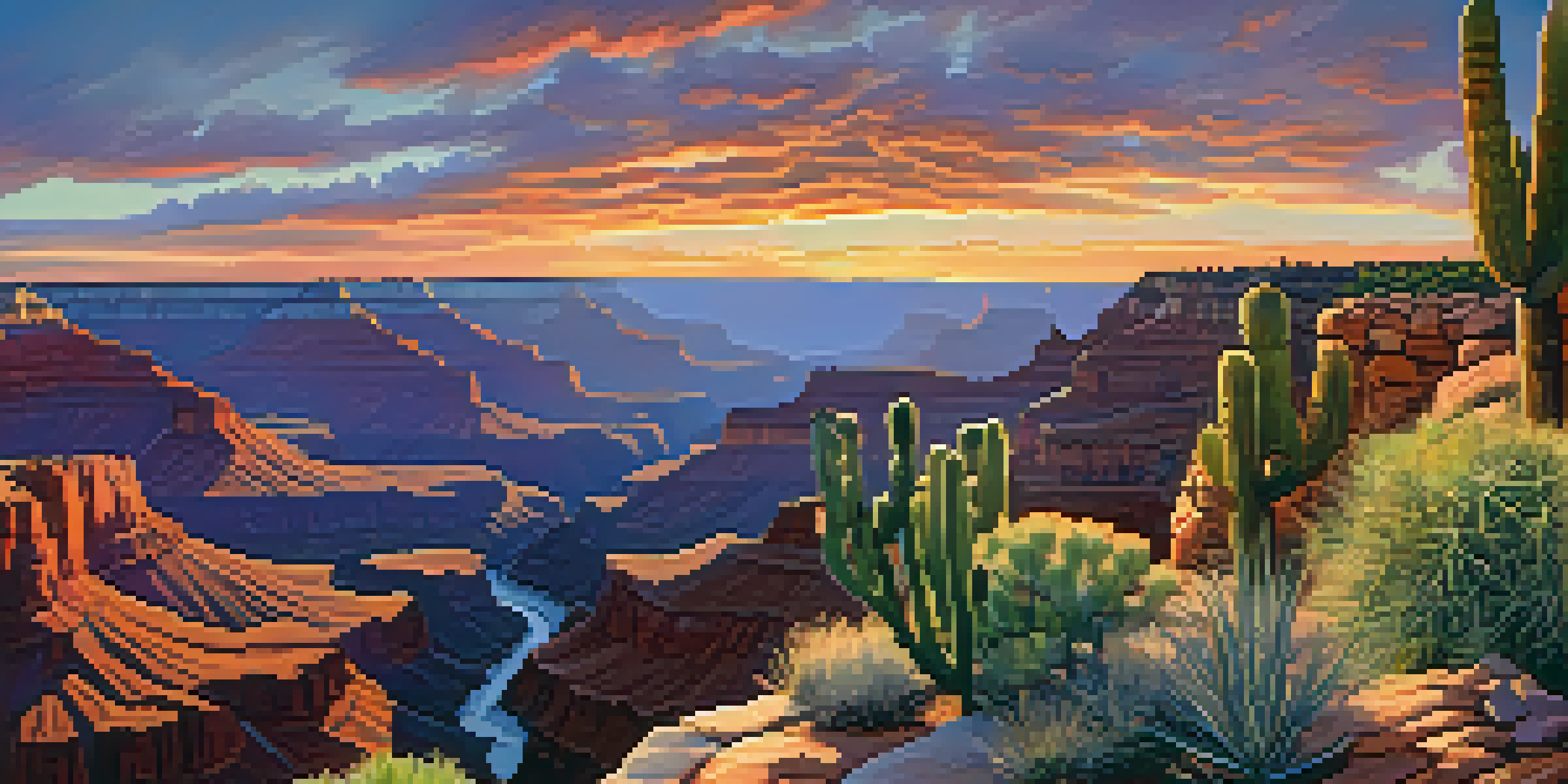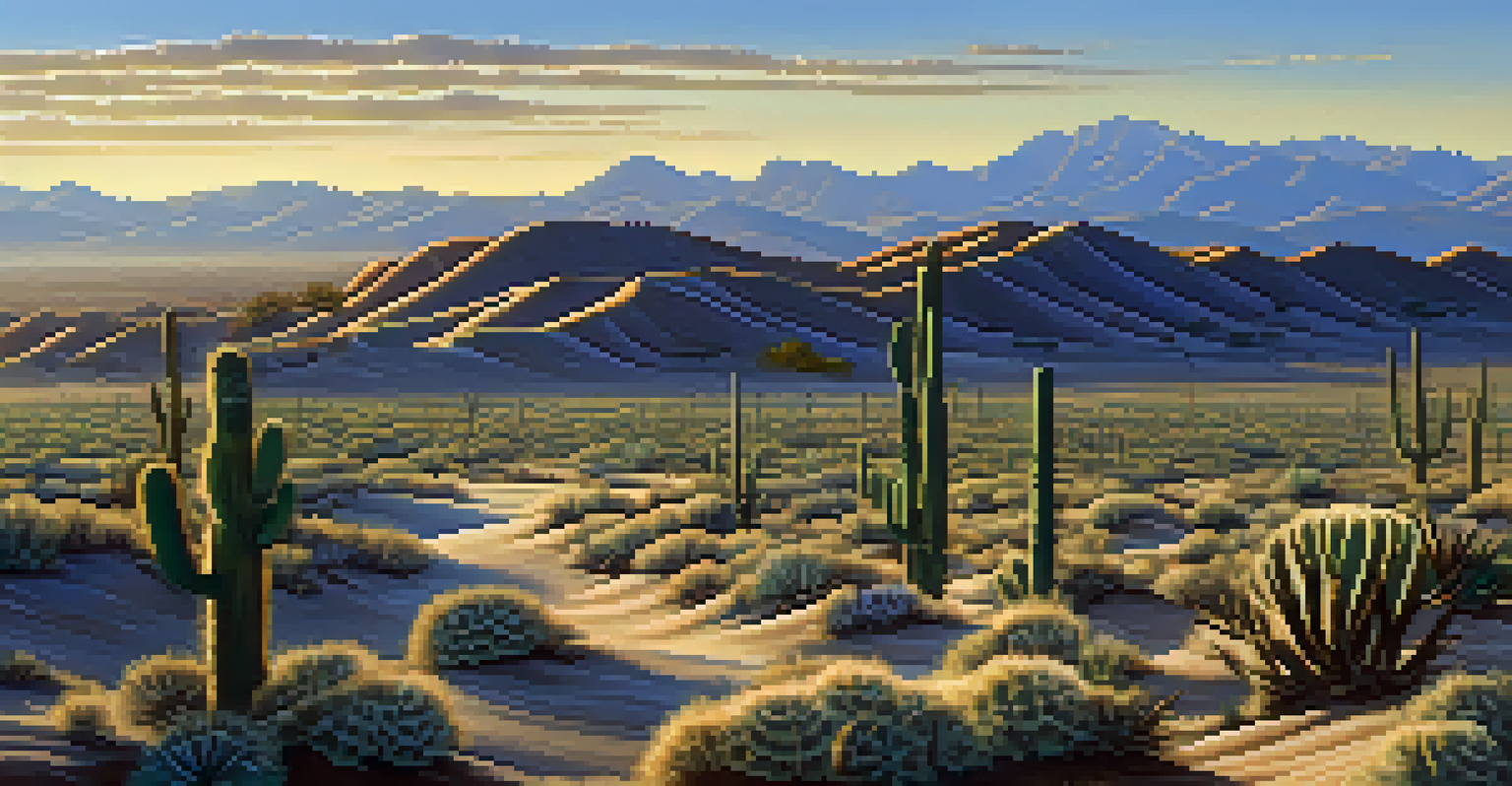Arizona's Unique Geography: A Core Element of the Southwest

The Grand Canyon: Nature's Masterpiece in Arizona
The Grand Canyon is undoubtedly Arizona's crown jewel, showcasing a breathtaking landscape carved by the Colorado River over millions of years. Its vastness and intricate rock formations draw millions of visitors each year, eager to experience its beauty firsthand. The layered colors of the canyon walls shift throughout the day, creating a mesmerizing display that feels almost magical.
The Grand Canyon is a natural wonder that has inspired countless generations to explore and appreciate the beauty of the earth's landscape.
This natural wonder is more than just a pretty view; it plays a crucial role in Arizona's ecology. The varying elevations and microclimates within the canyon create diverse habitats for countless species of plants and animals. From the desert flora at the rim to the lush vegetation along the river, the Grand Canyon is a living testament to the state’s rich biodiversity.
Moreover, the Grand Canyon serves as a cultural touchstone for many Native American tribes, who have lived in harmony with this land for centuries. Their stories and traditions are deeply intertwined with the canyon, adding a rich layer of history to its already impressive geological significance.
Deserts and Mountains: Arizona's Contrasting Landscapes
Arizona's geography is a fascinating blend of deserts and mountains, offering a unique backdrop for outdoor adventures. The Sonoran Desert, with its iconic saguaro cacti, stretches across the southern part of the state, providing a stark contrast to the towering peaks of the San Francisco Mountains to the north. This diversity in landscape creates a playground for hikers, rock climbers, and nature enthusiasts alike.

The high elevations in northern Arizona offer cooler temperatures and lush forests, making them a refreshing escape from the arid deserts below. Places like Flagstaff present a different side of Arizona, with pine trees, mountain lakes, and opportunities for winter sports. This surprising variety is what makes Arizona a year-round destination for adventure seekers.
Grand Canyon: A Natural Treasure
The Grand Canyon is a stunning geological marvel that showcases Arizona's rich biodiversity and cultural significance.
Additionally, the state’s varied terrains support a rich array of wildlife, from desert-dwelling creatures like the Gila monster to the elk roaming the highlands. This intricate tapestry of ecosystems underscores how geography shapes not only the landscape but also the living organisms within it.
The Colorado River: Lifeblood of the Southwest
Flowing through the heart of Arizona, the Colorado River is a vital resource for the region, providing water for millions and serving as a natural boundary. The river's journey through the Grand Canyon creates stunning vistas and recreational opportunities, from rafting to fishing. It is often seen as the lifeblood of the Southwest, nurturing both the land and its inhabitants.
In every walk with nature, one receives far more than he seeks.
The river also plays a significant role in agriculture, allowing farmers in the arid regions of Arizona to cultivate crops that would otherwise be impossible to grow. This irrigation system has transformed the desert landscape into fertile farmland, demonstrating the importance of water management in a dry climate. The balance between conservation and usage is a constant challenge, reflecting the ongoing struggle for this precious resource.
Moreover, the Colorado River is steeped in history, representing both the challenges and triumphs of human endeavor. From ancient Native American societies to modern-day water rights debates, the river's story is intertwined with that of Arizona, showcasing how geography influences culture and livelihood.
Canyons and Buttes: Arizona's Geographical Wonders
Beyond the Grand Canyon, Arizona is dotted with numerous canyons and buttes that tell a story of geological evolution. Places like Antelope Canyon and Monument Valley offer stunning vistas that showcase the state’s unique rock formations and vibrant colors. These natural wonders attract photographers and travelers who seek to capture their beauty in every season.
The formations are not just visually striking; they also provide insight into the Earth’s geological history. The swirling sandstone of Antelope Canyon, for example, was shaped by wind and water over centuries, creating a surreal environment that feels otherworldly. Understanding these processes helps us appreciate the forces that have shaped Arizona's landscape over time.
Diverse Landscapes for Adventure
Arizona's unique blend of deserts and mountains offers a variety of outdoor activities and ecosystems for nature enthusiasts.
These geological features also hold cultural significance for local tribes, many of whom view the land as sacred. Their stories and legends are tied to the canyons and buttes, enriching our understanding of Arizona's heritage. Exploring these areas offers a chance to connect with both nature and history, making them essential destinations.
Climate Diversity: From Desert Heat to Mountain Chill
Arizona's geography creates a striking diversity in climate, ranging from the scorching heat of the desert to the chilly mountain air. In the southern regions, summer temperatures can soar above 100°F, while the northern mountains experience winter snowfall and cooler temperatures. This variety not only affects lifestyle but also influences the types of flora and fauna that thrive in different areas.
The unique climate zones allow for a rich tapestry of ecosystems, from the iconic cacti of the Sonoran Desert to the lush forests of the Kaibab Plateau. As you travel through the state, you can experience all four seasons within just a few hours' drive. This climate diversity is one of Arizona's most appealing features, attracting visitors year-round.
Additionally, these varying climates present both challenges and opportunities for residents. Water conservation becomes critical in arid areas, while the cooler regions encourage winter sports and tourism. Understanding Arizona's climate helps us appreciate the resilience of its ecosystems and the adaptability of its people.
State Parks: Preserving Arizona's Natural Beauty
Arizona is home to numerous state parks that serve to protect and showcase its stunning natural beauty. Parks like Saguaro National Park, named after the iconic cactus, offer a glimpse into the unique desert landscape while providing opportunities for hiking, camping, and wildlife watching. These parks are essential for conserving the state’s rich biodiversity and cultural heritage.
In addition to preserving natural landscapes, state parks also promote outdoor recreation and education. They offer programs that educate visitors about Arizona's ecology, geology, and history, fostering a connection between people and the environment. This emphasis on stewardship is crucial for ensuring that future generations can enjoy these beautiful spaces.
Geography Shapes Culture and Economy
The state's varied geography influences agricultural practices, settlement patterns, and a thriving tourism industry.
Moreover, state parks contribute to local economies by attracting tourists, which supports businesses and creates jobs. The balance between conservation and tourism is vital for maintaining the integrity of these natural areas while also providing economic benefits to the communities surrounding them.
The Impact of Geography on Arizona's Culture and Economy
Arizona's unique geography has a profound impact on its culture and economy, shaping everything from settlement patterns to agricultural practices. The diverse landscapes have influenced the way communities develop, with cities like Phoenix and Tucson growing in the fertile valleys, while rural areas remain connected to the natural environment. This relationship between geography and culture creates a distinct identity for Arizonans.
Agriculture in Arizona, heavily reliant on irrigation from rivers like the Colorado, demonstrates how geography drives economic activities. Farmers cultivate crops that thrive in the warm climate, such as citrus fruits and vegetables, contributing significantly to the state's economy. This agricultural landscape reflects a deep understanding of the land and its resources, showcasing the interplay between geography and livelihood.

Additionally, Arizona's geography attracts a vibrant tourism industry, drawing visitors to its national parks, canyons, and historical sites. This influx of tourists not only supports the economy but also fosters appreciation for the state's natural beauty and cultural heritage. The ongoing dialogue between geography, culture, and economy is a defining feature of Arizona's identity.